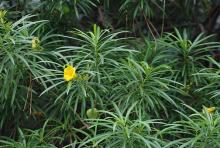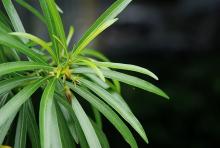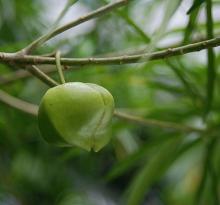Thevetia peruviana
Common name:
Yellow Oleander
Lucky-nut
Be-still tree
Cascabela
Captain Cook Tree
Pronunciation:
thev-VET-ee-uh per-u-vee-AN-uh
Family:
Apocynaceae
Genus:
Synonyms:
Cascabela thevetia
Type:
Broadleaf
Native to (or naturalized in) Oregon:
No
- Broadleaf evergreen shrub or small tree to about 25 ft (~8 m) tall. Leaves alternate, simple, 15 × 0.7 cm, linear-lanceolat, tapering tip, conspicuous midvein, other veins obscure, margin turned under (revolute). Showy flowers in clusters (cymes), subterminal, calyx 5-parted, corolla (petals) funnel form, 7 × 5 cm, saffron yellow to orange or peachy pink, fragrant. Fruit squat, angular, to 2.5 cm diameter, green then red and ripening to black.
- Caution: It has a milky sap (latex) which contains, among other things, thevetin (a cardiac glycoside, C42H66O18) with an action similar to that of the digitalis. This compound is extremely poisonous as are all parts of the plants, especially the seeds.
- Hardy to USDA Zone 9 (tropical) A close relative of Oleander (Nerium oleander). Possibly native to tropical Americas but now is found in much of the tropics, e.g., Pacific islands, parts of Southeast Asia, South Africa, Sri Lanka and South America. It can self-sow and can become weedy. It is a invasive pest and a declared weed in Australia where it is known as the Captain Cook Tree.







